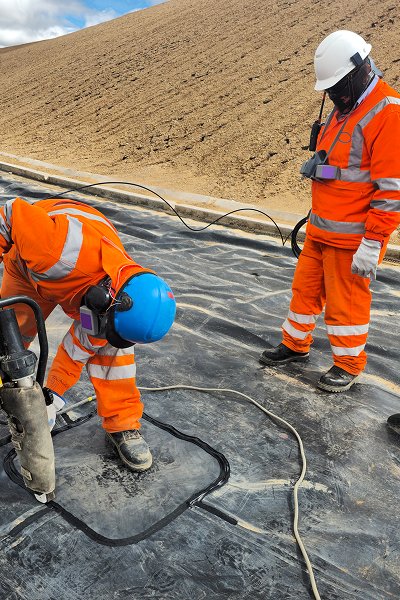What is HDPE geomembrane?
HDPE geomembrane is an anti-seepage membrane made of high-density polyethylene resin through extrusion, blow molding or calendering. It has the characteristics of close molecular arrangement, high crystallinity, strong rigidity and chemical corrosion resistance.

What is LLDPE geomembrane?
LLDPE geomembrane is made of linear low-density polyethylene resin, which contains more short branches in its molecular structure, so it has better flexibility and higher elongation at break, and is more suitable for engineering scenarios with complex terrain or requiring greater deformation capacity.

Flexibility comparison
Flexibility is the biggest advantage of LLDPE geomembrane. Because its linear molecular structure contains more branches, it shows better plasticity and softness.
HDPE geomembrane: harder, high tensile strength but not soft enough, not suitable for laying in complex terrain.
LLDPE geomembrane: can be laid freely in irregular or highly deformed terrain, can adhere to the base, effectively reduce gaps and wrinkles, and improve overall anti-seepage performance.
Elongation and stress cracking performance
HDPE geomembrane is prone to stress concentration and cracking under long-term load, especially under conditions of thermal expansion and contraction and uneven foundation settlement.
LLDPE geomembrane has better ductility, stronger resistance to stress cracking and ability to adapt to foundation settlement, and is particularly suitable for projects such as mountainous areas, tunnels, tailings dams, etc. with frequent settlement.
Chemical stability and weather resistance
Both materials have good chemical stability and can resist corrosion from acids, alkalis, salts, organic solvents, petroleum, etc., and are suitable for various harsh environments.
Due to its high density and high crystallinity, HDPE has slightly better chemical stability and is particularly suitable for corrosive liquid storage projects such as chemical pools, waste liquid pools, and landfills.
Life Analysis
The aging rate of HDPE geomembrane under ultraviolet rays, oxidation, and hydrolysis is relatively slow, and its service life is more than 50 years (under buried conditions).
Although LLDPE geomembrane has good flexibility, its life is generally 15 to 30 years due to its low density and slightly low antioxidant capacity, but it is sufficient for many short-term or medium-term projects.
Application cases
Landfill: excellent chemical corrosion resistance and long service life.
Large reservoir, channel anti-seepage: excellent performance in static engineering.
Chemical pool, tailwater pool, refinery lining: resist chemical erosion.
Metro structure anti-seepage: strong puncture resistance.
Tunnel lining in mountainous areas: complex terrain, frequent deformation.
Tails dam accumulation: serious uneven settlement.
Soft foundation anti-seepage: need to adapt to deformation.
Small temporary water storage tank or rainwater collection system: fast construction, strong deformation adaptability.




Five core advantages of HDPE geomembrane
Longer service life; HDPE (high-density polyethylene) geomembrane has a tight molecular structure and strong antioxidant ability. Under buried and shading conditions, its service life can reach more than 50 years, which is suitable for long-term closed anti-seepage projects.
Strong resistance to chemical corrosion; HDPE can provide excellent barrier properties for leachate from landfills or strong acid and alkali liquids in chemical pools. This feature is particularly critical in industrial and environmental engineering.
High strength and strong tensile strength; HDPE has good mechanical properties, especially in tensile strength, and is suitable for large-area paving and thin protective layer scenes.
Good resistance to UV aging; HDPE geomembrane usually adds auxiliary materials such as carbon black and antioxidants, which can maintain relatively stable performance even under strong ultraviolet radiation and is not easy to age.
Low cost; HDPE material supply is stable and processing cost is low, which is the preferred option for budget-sensitive projects, such as urban landfills and water conservancy dams.
Five core advantages of LLDPE geomembrane
Strong flexibility and high ductility; the structure of LLDPE (linear low-density polyethylene) determines its excellent flexibility and elongation at break, which can adapt to construction environments with complex terrain and large foundation settlement, especially suitable for slopes, waterproof pools, tailings dams, etc.
Better resistance to stress cracking; the chain structure of LLDPE can effectively absorb stress concentration and resist crack expansion, and is safer in scenes with large temperature differences or frequent load changes.
Easier to construct and weld; LLDPE has a wider melting zone during welding, and the construction workers have high fault tolerance, which is suitable for large irregular paving projects, such as ecological lakes, mountain tunnels, etc.
Good fit and strong sealing; on complex structure surfaces, LLDPE can fit the base tightly to reduce water accumulation in gaps, especially suitable for laying anti-seepage layers on vaults and concave and convex surfaces.
Excellent environmental protection: LLDPE material is soft and non-toxic, suitable for use in contact with soil and water bodies, such as ecological wetlands and water conservation areas, and has no adverse effects on the ecosystem.


